Nativity Scenes: The Reflection of the True Meaning of Christmas

I know it is hard to look beyond the holiday advertising and encourage children to embrace what Christmas is all about. When I was a child, my mom always set up a Nativity scene and told me that the season was about more than giving and receiving gifts, but rather about celebrating the birth of a special baby.
I hope this custom will never be lost, so I present this article and I wish to encourage people to help children learn that it’s not the gift itself that matters, but what’s behind the gift.
What is a Nativity scene?
A Nativity scene, also known as a manger scene, or Christmas crib Nativity set, is a visual representation of the birth of Jesus Christ. Typically displayed during Christmas, it consists of figurines depicting various characters and elements from the Nativity story.
The scene often includes the Holy Family—Jesus, Mary, and Joseph—alongside animals, shepherds, angels, and the Magi or Wise Men. Many also include a representation of the Star of Bethlehem. I have a basic nativity scene set, no star included, so I hung a Star of Bethlehem above it.
Why do people set up Nativity scenes?
“The Nativity scene is like a living Gospel rising up from the pages of sacred Scripture.”
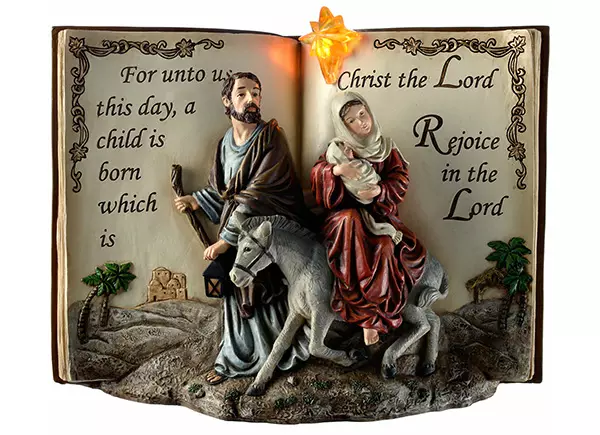
This is the most fascinating point of the Nativity scene. It serves as a visual representation of the birth of Jesus and the events surrounding it. It is a reminder of the true meaning of Christmas, focusing on the birth of Jesus Christ rather than the commercial aspect of the holiday.
Beyond its religious implications, the Nativity scene also holds cultural significance. It is a cherished tradition passed down through generations. The first known Nativity scene was built in 1223 in Greccio, Italy by Giovanni Velita for Saint Francis of Assisi to perform a Midnight Mass in front of on Christmas Eve. The scene featured live animals and was inspired by Francis’s visit to the Holy Land, where he saw Jesus’s traditional birthplace.
Traditions of Nativity scenes from around the world
Most countries have traditions of placing Nativity scenes and stables. While their key elements – the Holy Family, animals, shepherds, stars, angels, and the Magi – are similar, there are differences in their design and the cultures they express. This is so fascinating, Nativities can be used to both depict the birth of Jesus and convey unique cultural beliefs.
In France, besides the basic Nativity set figures, they also put statues called little saints. Those small hand-painted figurines represent various characters from the life of a Provençal village.
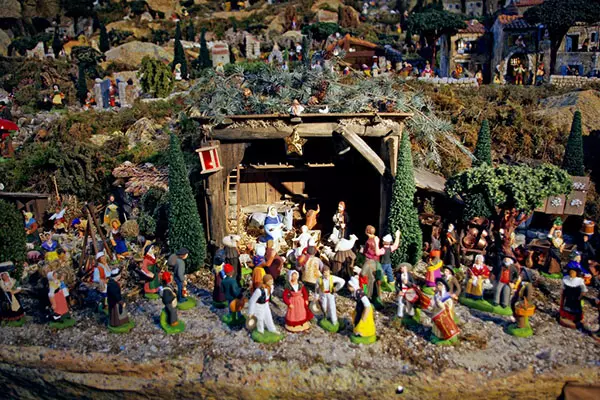
There is a tradition in Spain where an additional figure is added to the Nativity scene: the Caganer. It depicts a person defecating. People still aren’t sure when or how the tradition came to be, though it is seen by many as an “essential piece and the most popular figure of the Nativity scene.” In 2005, the Barcelona city council provoked a public outcry by commissioning a Nativity scene that did not include a Caganer.
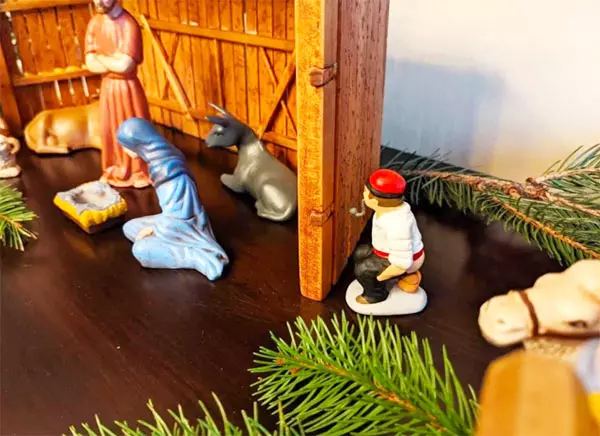
The Nativity scene and the stable in Poland is called Szopka. The feature of the Szopka is the use of historical buildings of Kraków as a backdrop for the Nativity of Jesus. Each Szopka is a mini version of Kraków and portrays St Mary’s Basilica with its easily recognizable spires, Wawel Castle, Sukiennice trade hall, and Barbican.
The first floor is occupied by figurines representing historical figures, artists, and characters from the Urban Legends. The Nativity scene is placed on the second floor.

Germany has a special tradition of how to set up a Nativity scene: they wait until Christmas Eve to put the Holy Child Jesus in the manger. Until then, each time the children do a good deed, they can put a small piece of hay or golden yarn in the manger to help create a soft bed for Jesus.
Different types of Nativity sets
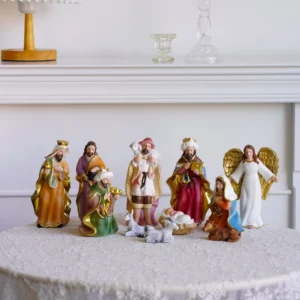
Mini Nativity Scene
A mini Nativity scene also called a table Nativity scene, is a miniature representation of the Nativity, consisting of several figurines, some with a stable. Each figurine is only a few inches high and is usually made of hand-painted resin or ceramic. We often used it for display on bookshelves, tables, or under the Christmas tree.

One Piece Nativity Set
A one-piece Nativity set is a more biblically accurate version, it doesn’t have the three wise men and the shepherds – I mean these important elements did throughout the story, but not at that moment. Most scenes depict shepherds and magi appearing in a manger immediately after Christ’s birth – however, Matthew’s Gospel suggests that the magi followed the star to Jesus’ home a year or so after his birth.
I understand the Nativity scene is not to be a photorealistic documentary, but a one-piece Nativity set is a good choice.
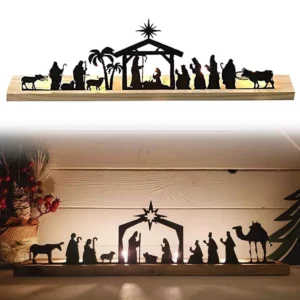
Metal Nativity Set
The metal Nativity scene is crafted from metal, usually in a simple silhouette, and contains all the elements of the story. It is beautiful and affordable. Perfect for a mantle under a small table, tree, or an inside window display.
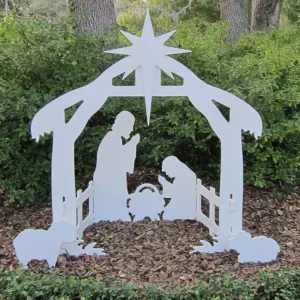
Plastic outdoor Nativity scene
A plastic outdoor Nativity scene is generally used for yard displays. Although the material is plastic, it may sound a little cheap. Actually, the full name of the plastic is Marine Grade Plastic PVC Sheet. This material has largely replaced plywood as the primary marine substrate because of its durability.
Plastic outdoor Nativity scenes often come in larger sizes and can be used in the harshest weather conditions. Snow, ice, water, wind, or sun – no problem.
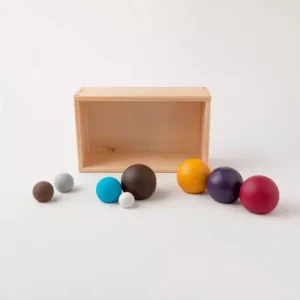
Modern Nativity Scene
Modern Nativity scenes are often presented in a minimalist design, but still convey the full story of the traditional Nativity scene.
Some designs come with film-themed characters, such as the Baby Yoda Nativity, and others that are very abstract, such as this one, If the spheres were on their own, I’d have never figured out it was meant to be a Nativity scene.

Children’s Nativity Set
Children’s Nativity Set is designed for little hands and is robust, durable, and safe. They are not just for Christmas decorations; they allow the little ones to re-enact the Christmas story of Jesus’ birth with figures suitable for kids.
Among the many materials available for children’s Nativity scenes, I particularly recommend wooden Nativity scenes, which are made of natural and environmentally friendly materials and do not contain any harmful substances.
When should a Nativity scene be taken down?
Actually, there is not necessarily a right or a wrong answer to this question. Nativity scenes are customary and are not determined by official norms.
Traditionally, the Nativity scene and any other decorations should be put up at the latest by Christmas Eve (24 December) and dismantled at the latest by Epiphany (6 January) or the end of the Julian Christmas celebrations (7 January). Epiphany marks the visit of the Magi to the infant Jesus and is considered the official end of the Christmas season. Taking down the Nativity scene on this day signifies the conclusion of the holiday celebrations.
Another popular practice is to extend the display to Candlemas, celebrated on 2 February. My family has maintained the tradition of taking it down on the eve of Candlemas for many years. We usually wait to add the Magi at Epiphany. Since the Magi have only just arrived at the manger, the manger stays in place until Candlemas, just like the bigger version in the church.
Ultimately, the decision of when to take down a Nativity scene is a personal one. You are free to display it at any time. Just enjoy!
Conclusion
This is all about a Nativity scene, thanks for reading, if you are interested in Nativity scene settings in different countries, I shared how to set up a Nativity scene here.
That now concludes my article by recommending a film about the birth of Jesus that is suitable for viewing with children: The Star (2017).
It is an animated film that tells the Nativity story from the perspective of the animals who witnessed the birth of Jesus. This family-friendly movie offers a fresh and humorous take on the traditional story, making it accessible and enjoyable for younger audiences.
